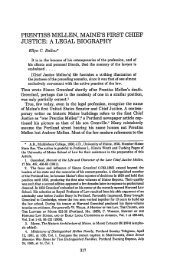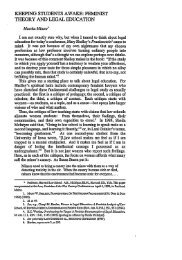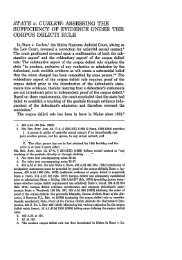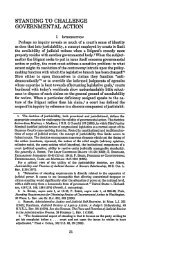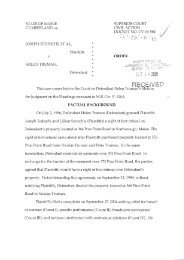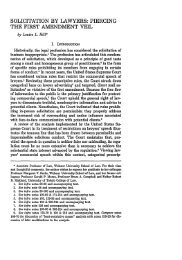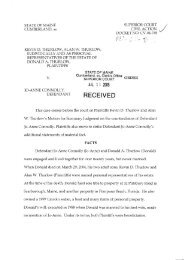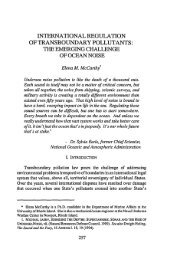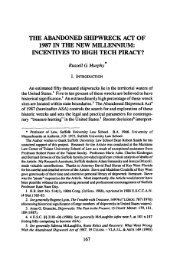Outlining a Legal Research Paper
Outlining a Legal Research Paper
Outlining a Legal Research Paper
You also want an ePaper? Increase the reach of your titles
YUMPU automatically turns print PDFs into web optimized ePapers that Google loves.
Dave Owen<br />
Fall, 2011
Introduction<br />
Background<br />
(Methodology and results (if your research involved<br />
collecting and analyzing a database)<br />
Analysis/Argument<br />
Conclusion<br />
Most legal research papers employ some version of this basic structure. The slides<br />
that follow explain what should be included in each of the sections.
Introduction<br />
Introduce the question you’re addressing<br />
Explain why that question is important<br />
Explain your thesis<br />
Background<br />
Analysis/Argument<br />
Conclusion
Introduction<br />
Background<br />
Transition from introduction<br />
Provide the factual context for your question<br />
Provide the legal context for your question<br />
Explain, briefly, what others have said about your<br />
question<br />
Analysis/Argument<br />
Conclusion<br />
No hard and fast rule requires the legal background to precede the factual background, or<br />
vice versa. You might also have multiple sections describing the background law or facts,<br />
particularly if your paper addresses the intersection of two or more societal problems or<br />
areas of law.
Introduction<br />
Background<br />
Provide the factual context for your question<br />
Summarize the story, or stories, behind the legal<br />
controversy you’re writing about<br />
Provide the legal context for your question<br />
Analysis/Argument<br />
Conclusion
Introduction<br />
Background<br />
Provide the factual context for your question<br />
Provide the legal context for your question<br />
Explain the relevant law<br />
Explain the controversy or problems (real or perceived<br />
by others) with existing law<br />
Analysis/Argument<br />
Conclusion<br />
When explaining the controversy you’re addressing, be sure to explain what other legal<br />
authors have said about that controversy. If the subject just hasn’t been addressed (a rare<br />
circumstance), be sure to point that out. Your reader will want to know where your<br />
argument fits in the debate and how it advances that debate.
Introduction<br />
Background<br />
Analysis/Argument<br />
Reintroduce your thesis<br />
Support that thesis<br />
Address alternative points of view<br />
Conclusion<br />
The slides that follow provide two examples of a general structure of an analysis section.<br />
These are not the only options, and you can structure your analysis in many other ways.<br />
The key is to have a structure. Think about how your overall argument can be divided into<br />
component sub-parts, then about how those sub-parts can be further divided, and then<br />
about how each fact, assertion, or claim fits within that structure. Divide and organize<br />
your sections, subsections, paragraphs, and sentences accordingly. Then use transition<br />
sentences and summary paragraphs to tie the pieces together.
Thesis: the law of A should be changed because<br />
the current approach is premised on flawed<br />
assumptions, relies on internally inconsistent<br />
reasoning, and leads to bad policy outcomes<br />
begin with a mini-introduction that transitions<br />
from the prior section and summarizes your<br />
argument<br />
Part A – Flawed Assumptions<br />
Part B – Internally inconsistent reasoning<br />
Part C – Bad policy outcomes
Thesis: The law of B should not change, because<br />
while the current law is flawed, all available<br />
alternatives are even more undesirable<br />
begin with a mini-introduction that transitions from<br />
the prior section and summarizes your argument<br />
Part A – current law is flawed<br />
Explain Flaw 1<br />
Explain Flaw 2<br />
Part B – alternatives approaches would be even worse<br />
Explain alternative 1 and its problems<br />
Explain alternative 2 and its problems
Introduction<br />
Background<br />
(Methodology and results)<br />
Analysis/Argument<br />
Conclusion<br />
Briefly summarize question addressed, conclusion<br />
reached<br />
Do not introduce a new argument
The introduction doesn’t contain a thesis<br />
The background sections are too long<br />
The background sections contain too much<br />
information and not enough synopsis<br />
The background sections don’t relate to the<br />
argument<br />
The argument is too short<br />
Different sub-arguments are jumbled together<br />
Different sections and subsections aren’t linked<br />
with transitional language<br />
The argument is one-sided or inadequately<br />
researched<br />
The article contains grammatical and spelling<br />
mistakes



